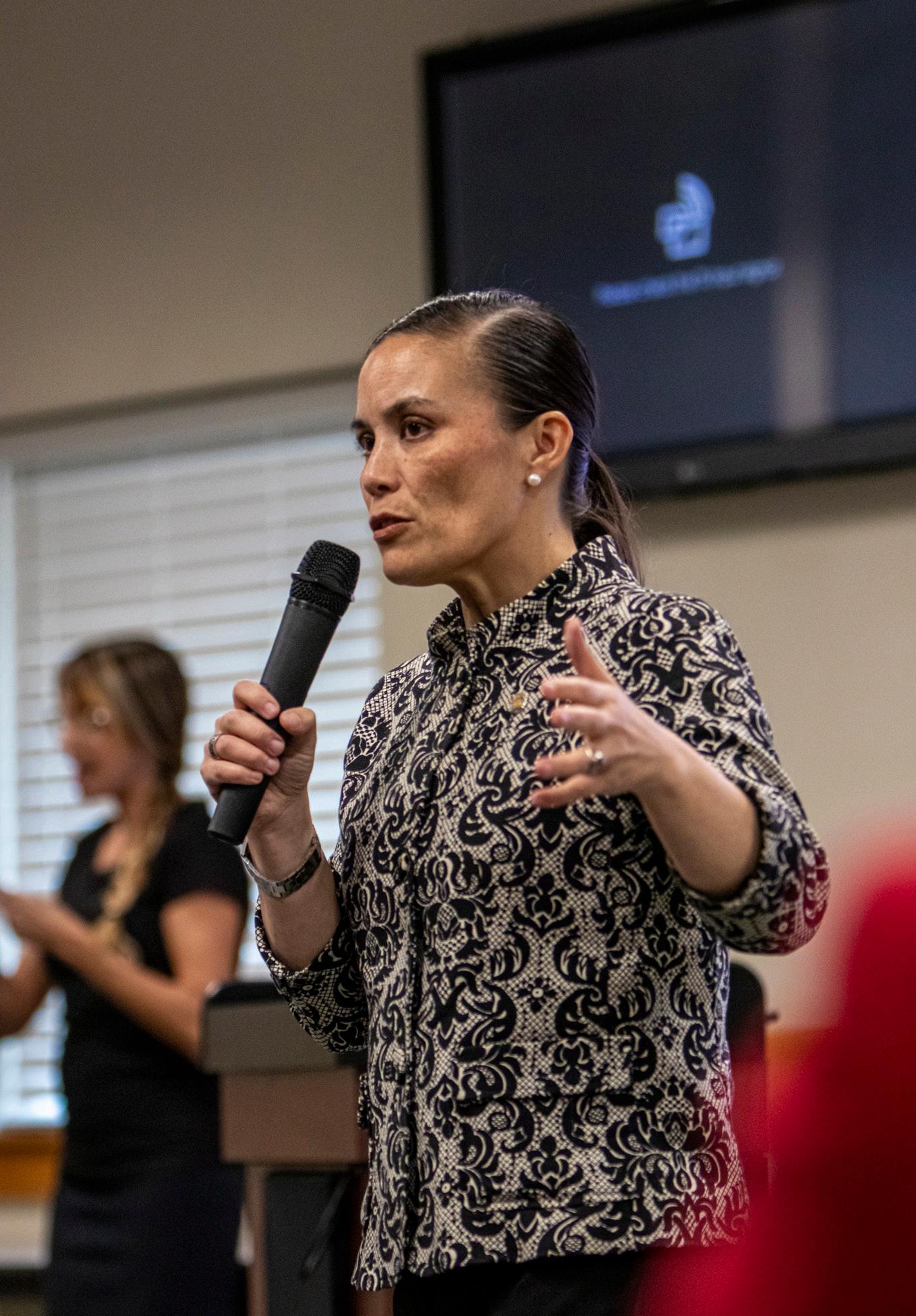










By Henry Holmes Staff Writer
The Texas Supreme Court has indicated its plans to eliminate the American Bar Association’s ability to accredit law schools. For the past 42 years, the ABA has provided the standard that Texas law schools are held to and determined which law schools can have their students take the Bar Exam.
Texas will soon be the only state fully independent of the ABA, and the Court alone will determine who can practice law within its borders. In response, numerous law schools in the state have raised concerns about Texas’ ability to stay competitive and remain transparent for law students.
Test scores and grade point average of admitted students that year, class size and admission rates.
On Sept. 26, the Texas Supreme Court released a notice indicating its position.
“[The] Court is of the tentative opinion that the ABA should no longer have the final say on whether a law school’s graduates are eligible to sit for the Texas bar exam and become licensed to practice law in Texas.”
The notice explained that the court will make a final decision in December to take effect on Jan. 1, 2026. The Court is currently open to comments on the issue, noting that it does not anticipate the change will negatively impact the state’s law schools and hopes to preserve the current stability. No reasoning for the expected change was given.
Following the Court’s statement, St. Mary’s Law
schools’ overall employment rates, and harm Texas law schools’ national reputations,” they wrote. “The Court recognized the importance of portability when it approved transitioning to the [Universal Bar Exam]; removing ABA accreditation will impair that portability and geographic mobility for new and already licensed lawyers.”
The deans also addressed the recent scrutiny the ABA has faced from the federal government for its diversity, equity and inclusion initiatives. They noted how the ABA has suspended its DEI practices until August 2026, for revision and how the education council that accredits law schools is independent of the ABA by law.

They further urged the Court and the Texas legal community to take other reform measures rather than severing the ABA entirely. To the deans, this would mean directly collaborating with the ABA, identifying regulatory concerns and supporting continued innovation. understand how law students and faculty are reacting to the expected change, The Paisano interviewed David Sokolow, a Distinguished Senior Lecturer at the University of Texas Law School. asked about how the change might impact Texas Law, Sokolow indicated that while serious differences may not be felt within the state, individual students may bear the cost.
don’t think there’s going to be a big impact within the schools or within the state,” Sokolow stated. “The big question is what’s going to happen to a University of Texas or a Texas Law degree if students from Texas are not going to be able to get jobs in other states; that’s going to be a huge problem.”
During the interview, Sokolow was shown the letter from the deans and largely agreed with their stance.
“You can’t sugarcoat this,” Sokolow explained. “This will be incredibly detrimental to the University of Texas School of Law.” Sokolow also addressed prospective law students, urging them to pay attention to the court’s final decision. “[Currently], our degree is totally portable [between states], not if this [decision] is adopted,” Sokolow said. In addition, he does not believe the Texas Supreme Court has the resources to fill the gap the ABA will leave. Until the final ruling and the Court gives other notice, currently approved law schools will retain their accreditation. Readers can submit comments to the Court before Dec. 1 to rulescomments@txcourts.gov.
By Miles Jones Staff Photographer
Support and Defend, a San-Antoniobased veteran organization, hosted a press conference to convey their concern to veterans and the wider San Antonio community about the misuse of the military, and advocate for the right to refuse illegal orders. Members from the organization were joined by State Representative Ray Lopez of District 125, who gave remarks concerning recent events, including the use of the National Guard as a police force in multiple U.S. cities and Secretary of Defense Pete Hegseth’s meeting with top military officials.
The press conference began at 10 a.m. on Oct. 7, held in the free speech zone in front of City Hall. The crowd was sparse, mostly consisting of members from Support and Defend, with no city officials in attendance.
Vietnam veteran Tom Wetzler opened the press conference with background on what the organization represents.
“Support and Defend is a multigenerational, multi-service organization of San Antonio veterans who are dedicated to supporting and defending the Constitution,” Wetzler stated. “We come from many different experiences of service and different opinions. However, we all agree that the current administration is misusing our military in an un-American way that is a threat to our nation.”
Retired Army Lt. Col Martha Spinks spoke on President Donald Trump and Secretary of Defense Pete Hegseth’s meeting with top U.S. military officials on Sept. 30.
“One week ago, Donald Trump declared war on America. The president and the secretary of war identified the greatest threat to the United States as the enemy within,” Spinks said.
Spinks also advocated for the importance
of the right and responsibility to disobey illegal orders, adding that it is ultimately the civilians’ responsibility to support and defend a service member if they choose not to obey an order that they deem illegal.
“The average person in the military is somewhere between 17 and 23 years old,” Spinks said. “Some kid from Tuskegee, Alabama is going to have to say to a commander, ‘No, I’m not going to do it.’”
Retired U.S. Army veteran Fred Hofstetter spoke about the Posse Comitatus Act. The Posse Comitatus Act is a federal law that limits the use of federal military personnel to enforce domestic law. Hofstetter added that the National Guard can participate in law enforcement in their home state if consistent with state law; however, when they are federalized, they are bound by Posse Comitatus.
“Our organization, Support and Defend, does not support using our military to target our citizens. We also don’t want or need them raking leaves and picking up trash,” Hofstetter said. “Our country and our warriors are better served if they are at home training for real missions and spending time with their families.”
State Representative Ray Lopez spoke last. Lopez addressed what he believed to be the damage the current administration and its policies are inflicting on future military recruitment.
“This is creating so much chaos that what’s going to happen in future generations that need to be in the military, they need to come and protect and defend, are not going to because there’s so much confusion and so much concern,” Lopez remarked.
The press conference concluded at 10:30 a.m.
“We’re going to be wrapping up now because this is the free speech space in front of the City Hall, but not all day,” Spinks joked.
Support and Defend will be at the No Kings protest on Oct. 18 in Travis Park.
Mayor Jones acknowledges shutdown at District 10 meeting
Read article at paisano-online.com
By Marisela Cruz News Editor

State of the City Week of 10/14
By Lori Zaragoza
Contributor
Not subscribed to local news but still want to stay up-to-date on the happenings around town? Look no further.
Highlighting notable stories from external San Antonio news sources, State of the City summarizes the most captivating news headlines of the week. This week’s topics are about the Light the Night event, the community of San Antonio helping a veteran barber, and the Ballet San Antonio ‘Giselle’ performance.


By Alejandra Garza Staff Writer
The Food and Drug Administration silently approved a new generic form of the abortion pill mifepristone on Oct. 2. Drugmaker Evita Solutions publicized that the FDA signed off on its form of mifepristone, allowing the termination of pregnancies through 10 weeks. The original approval of Mifepristone was in 2000, and access to it has since become increasingly restricted.
This is the second generic version of the pill to be available aside from the previous product created by the pharmaceutical company GenBioPro. With this approval, multiple anti-abortion organizations and conservative political figures have expressed their concerns.
“Secretary Kennedy and FDA Commissioner Makary assured Congress and the American people they would conduct a thorough review given credible evidence of the harm inflicted by these drugs,” President of the anti-abortion group Susan B. Anthony Pro-Life America, Marjorie Dannenfelser, said. “The prompt completion of the review is made more urgent given this approval to flood the market with a cheap abortion drug.”
Chair of the Health, Education, Labor and Pensions Committee Sen. Bill Cassidy released a statement on the approval.
“I fully support President Trump’s ProLife, Pro-Family agenda, but the FDA approving one more tool to kill babies is a betrayal,” Cassidy said. “This is not what
Commissioner Makary and Secretary Kennedy indicated they would do in their confirmation hearings.”
There are 51 Republican senators who have signed a letter to the FDA and the Health Department advising them to revoke their approval of the new abortion pill. The letter cites research conducted by the Ethics and Public Policy Center, a Washington D.C.-based think-tank, showing that women may experience adverse health issues following the consumption of Mifepristone. Additionally, senators asked for the suspension of distributing Mifepristone.
Health Secretary Robert F. Kennedy Jr. and FDA commissioner Dr. Marty Makary sent a letter to Republican attorneys general pledging to conduct a full review of the drug’s safety, less than two weeks after the FDA approval.
The Health and Human Services Department has expressed that the FDA does not endorse drug products and has very limited deciding powers whether to approve a drug.
“The FDA has very limited discretion in deciding whether to approve a generic drug. By law, the Secretary of Health and Human Services must approve an application if it demonstrates that the generic drug is identical to the brand-name drug,” HHS spokesperson Andrew Nixon said in a statement.
In most cases, the FDA issues press releases after any new or significant drug, but did not do so in this case. The drug is expected to be available and launched in January of next year.

Light the Night San Antonio citizens gathered on Saturday Oct. 11 for a “Light the Night” event to honor people that have been affected by blood cancer and their families. The event took place at The Rock at La Cantera. Those in attendance consisted of survivors, supporters or the families of those that have been lost to the disease, each carrying a different colored lantern to symbolize why they were there: white lanterns for survivors, gold lanterns symbolizing the memory of loved ones and red lanterns carried by supporters.
On Friday Oct. 3, Ballet San Antonio will donate 1,000 free tickets to federal employees that have been affected by the government shut down for Oct. 17-19 at the H-E-B Performance Hall inside the Tobin Center for the Performing Arts. The production will give 250 tickets at four performances. The performances are scheduled for Oct. 17 at 7:30 p.m., Oct. 18 at 2 p.m. and 7:30 p.m. and Oct. 19 at 2 p.m. This is offered to the thousands of federal employees in San Antonio that have been affected by the shutdown.
Community helps veteran barber
Keith Harris is a marine veteran that has offered free haircuts to the homeless, other veterans and children of single parents. In August, his mobile trailer that he turned into his barber shop was stolen. This theft led Devils River Whiskey CEO Mike Cameron to notice Harris’ story. Cameron invited Harris to a fundraising gala where Harris was given $5,000
Editorial
President Donald Trump’s administration has sent The University of Texas at Austin and eight other colleges a letter requesting agreement to a “set of operating principles” in exchange for federal funding. The schools would have to agree to a stricter definition of gender, a limit on international student enrollment and a five-year tuition freeze, among other rules. The decision deadline is Oct. 20, and UT Austin is considering the agreement, endangering its integrity and reputation.
The letter, officially titled the Compact for Academic Excellence in Higher Education, was sent to the University of Arizona, Brown University, Dartmouth College, Massachusetts Institute of Technology, the University of Pennsylvania, the University of Southern California, the University of Texas, the University of Virginia and Vanderbilt University. UT Austin and the other schools would have to ban the use of race and gender considerations during the hiring process, cap international enrollment at 15%, cap international enrollment from single countries at 5%, stay politically neutral, require applicants to take the SAT or a similar test, correct academic programs that threaten conservative views, become stricter on disruptive protests and refund tuition to students who
drop out within the first year. These outrageous requests from the Trump administration are another attempt to tear down free speech, academic freedom, institutional independence and diversity, equity and inclusion. May Mailman, a senior adviser for the White House, told the Wall Street Journal that the administration does not plan to limit funding to only those institutions

that sign the agreement, but they will receive priority in funding and engagement with the White House. In its manipulative nature, the administration is giving these schools an ultimatum: independence or priority federal funding — a complete exchange of academic
By Lina Arraour Contributor
Operation Midway Blitz is underway — whether states like it or not. President Donald Trump’s administration’s latest stunt extends the National Guard nationwide to protect Immigration and Customs Enforcement, targeting Democratic-led states, like California, Illinois and Oregon.
The so-called “war ravaged” city of Portland has received 200 members of the Oregon National Guard at its doorstep, as Trump claims ICE facilities are “under siege from attack by Antifa, and other domestic terrorists.”
The protests, however, are “largely sedate,” as confirmed by Trumpappointed Oregon District Judge Karin Immergut, who issued a temporary restraining order against the administration’s invasion — writing that protests with fewer than 30 people, known for their absurd and comical costumes or performances, do not merit a military response. With time to waste and enemies to invent, the Trump administration appealed anyway.
Trump’s favorite talking points continue to be cities like Seattle and Portland — which he claims are crumbling under liberal leadership. Yet, facts — as inconvenient as they are for the president — tell a different story. A senior research specialist for the Nonpartisan Council on Criminal Justice notes that violent crime in Seattle is actually decreasing. While both cities rank higher than the national crime average, they remain incomparable to Republican-led cities like Memphis and Alexandria, proving that crime does not correlate with a state’s political party.
without cause, arrested non-criminals, fatally shot a Mexican immigrant and even injured a CBS News Reporter with a pepper ball unprovoked. Outside Chicago’s Broadview ICE detention center — another target of Trump’s deployments — protests have taken place to send a message of plea, desperately demonstrating the citizens’ justified right to refuse the deployment of the national guard.
On Oct. 4, despite objections from Illinois’ governor and the mayor of Chicago, 200 members of the Texas National Guard were deployed alongside 300 Illinois National Guard troops to “protect” ICE facilities and personnel in Chicago.

Chicago Federal Judge temporarily blocked further deployments, but the damage was already done — an armed presence within city limits, justified by little more than see-through “crime” statistics and political spite. On Truth
Social, Trump suggested Illinois Democratic Gov. JB Pritzker and Mayor Johnson “should be in jail” for failing to protect ICE agents after their joint lawsuit against the person truly failing is the president himself. His duty is to protect and serve all constituents, not just those who look, think and speak like him. Operation Midway Blitz is not about security — it is about spectacle and how far Trump can push before Americans push back.
What truly drives chaos in these communities is not progressive governance — it is federal interference. Chicago’s DHS agents have detained U.S. citizens
These blunders serve as proof of a disgraceful administration — one that disrespects both the citizens it governs and the Constitution that grants it authority. Operation Midway Blitz is no act of patriotism. It is a performance of power — a president waging war not on crime, but his own country.
freedom for money. Funding higher education is optimal, but not at the expense of institutional integrity. Among the colleges, only MIT has rejected the offer, holding itself, as always, to a higher standard. MIT has refused to let its principles crumble under the administration’s obvious pressure; in a letter to the Department of Education, MIT listed its values, priding itself on rewarding merit, its open door to the most talented students regardless of family finances and free expression. Meanwhile, UT Austin is reviewing the offer, claiming it was “honored” to be a part of the proposal. If UT Austin accepts, yet another strong-standing, respected Texas institution will have succumbed to Trump’s discriminatory requests. Already, multiple state universities have expelled students and fired professors due to unwanted political opinions and restricted gender identity education because of the Trump administration and its golden child, Gov. Greg Abbott. Academic freedom will always remain more important than monetary gain, and by rejecting this offer, these schools will maintain their reputable education, diverse student bodies and inclusive values. UT Austin must set itself apart from other public universities in the state by holding itself and its student voices to a higher standard. The eradication of academic freedom in Texas does not have to win, and UT Austin can be the first to go against the grain.
Commentary
By Audrey Villar Web Editor
The Pentagon has decided to terminate the Defense Advisory Committee on Women in the Services. The Pentagon’s Press Secretary Kingsley Wilson posted on X on Sept. 23 to announce the dissolution of the group, citing the reason as DACOWITS being “focused on advancing a divisive feminist agenda that hurts combat readiness.”
This is one of many moves U.S. Secretary of Defense Pete Hegseth has made this year under the guise of eliminating military functions that facilitate inequality and ruin efficiency, but the cancellation of programs and groups that reach a hand toward those affected by bias and discrimination does not actually help the military; it furthers the gap between the privileged white male and military women.
DACOWITS consisted of civilians selected to help make decisions on matters involving women in the military. From integration to their treatment, research and policies were implemented to help women stand on equal ground as men in an already gender-divided institution.
Hegseth has made it clear that inclusive programs no longer have a place in the Armed Forces, saying, “We’ve said goodbye to the harmful effects of woke culture and socalled diversity, equity and inclusion programs,” and noting a change to base
military operations “on performance, not immutable characteristics.”
Working within a society that suffers from deeply ingrained bias and discrimination, especially in the military, makes it impossible to ignore a person’s gender. By doing so, the services show a blatant disregard for the well-being of onefifth of their members. This is not a pursuit of equality; it is blatant sexism.
In an address to military personnel in Quantico, Virginia, Hegseth said that combat roles will have the “highest male standard” imposed upon them. To try and disguise this as anything other than an exclusionary procedure — using males as the measure for a satisfactory military member — is a flagrant and poorly hidden misogynistic ploy.
Women will have to work much harder to achieve recognition, something they already had to do even with the defense of the DACOWITS. They should instead be evaluated based on female physicality. By forcing women to aim for physical male standards, the gap between men and women intentionally widens.
Without the DACOWITS to advocate for women in the services, Hegseth will readily be able to inflict a sex-based discriminatory agenda on the military. Since DACOWITS’s founding in 1951, they havemade over 1,100 recommendations to the Secretary of Defense advocating for equality measures in the services. Now, when Hegseth announces that women will not get inclusionary treatment, they will have no committee to defend them.

Commentary
By Iyanu Muyiwa Contributor
The U.S. recently imposed a $100,000 fee on new H-1B visa applications. Previously, fees ranged from $2,000 to $5,000. The change is drastic, immediate and far-reaching. This is not a small adjustment; it is a barrier: a financial wall that threatens technology, healthcare, education and the companies that fuel innovation. Small businesses and startups face the brunt of the consequences. They lack the resources to pay. Large corporations like Nvidia have promised to cover the fee for some employees, but promises cannot erase the fact that many companies will stop hiring skilled foreign workers. Innovation will slow. Growth will slow. Opportunities will vanish because innovation depends on access to people and ideas that fuel progress. The H-1B program
has long been the path that connects American companies to overseas talent. When that connection and access costs $100,000, only the wealthiest can move forward — while everyone else loses the chance to compete.
Healthcare and education will feel the impact next. In Houston, hospitals and medical centers rely on immigrant professionals, many starting on H-1B visas. Institutions, like MD Anderson Cancer Center and the University of Texas Health Science Center, now face uncertainty. Staffing shortages loom. Access to care for vulnerable communities could suffer. Schools and universities that employ foreign faculty face similar challenges. Academic programs, research projects and student opportunities are all at risk.
Legal battles about the new fee have already begun. The American Association of University Professors and other organizations have filed lawsuits, arguing the policy harms underserved communities that rely on foreign
talent. International concerns are mounting too. Indian officials warn the fee could disrupt service exports and remittance inflows. Tech industries dependent on Indian professionals may struggle to meet demand.
This policy is not just about money. It is about the message the U.S. sends. The nation has long been a magnet for global talent. Doctors, engineers, educators and innovators come to the U.S. seeking opportunity. They fuel industries, enrich communities and advance knowledge. A $100,000 fee tells them they are now too expensive to be welcome.
The $100,000 H-1B fee is a regressive policy. It threatens the country’s role as a global leader in innovation and economic growth. It risks alienating the very talent that drives progress. Policymakers must reconsider this fee. Alternatives exist: solutions that attract — not deter — the best and brightest from around the world.
Kassandra Jaime Contributor
Adelita Grijalva, a prominent Arizona politician, eagerly awaits being sworn into the 119th Congress. She is the daughter of former congressman Raul Grijalva, who served for two decades until his passing in March. While being sworn in is the official proclamation to represent the 800,000 civilians in Arizona’s 7th Congressional District, Grijalva lacks the keys to her office in Congress because Republican Speaker Mike Johnson refuses to swear her in.
Grijalva must represent the needs of
government’s lack of acknowledgement towards Grijalva’s swearing day; however, the GOP’s actions towards other Rep.elects show otherwise.

While Grijalva has waited over two weeks to be sworn in, Johnson saw no issue with swearing in Republican Florida Rep.-elects Jimmy Patronis and Randy Fine on April 2 during another pro forma session — a brief affair that occurs during times when no votes take place. The absurd excuse behind this exception was that the reps already had family and supporters ready to cheer them on. Their circumstances seemed meager compared to Grijalva, who acknowledged her father’s prominent role in public service and her many social media posts depicting that she would camp outside of the White House, hoping to be sworn in. Johnson’s biased inability to comprehend the backlash he would receive for this dispute casts light on the broader reasoning behind Grijalva still not being sworn in. cited various reasons for Grijalva’s swearing-in deprivation, one of them being their refusal to accept Republican ideologies. The government shutdown on Sept. 30 sent all Republican representatives back home after undergoing disputes about the Affordable Care Act. As Democrats stand firm on denying any decrease in healthcare budgeting, Republicans have used Grijalva’s swearin date as a dangling carrot to convince Democrats to return and sign off on Republican-led initiatives. Considering
such tactics used by the Republicans, it is pivotal to highlight the importance of Grijalva’s access to voice her concerns as a newly elected representative.
“I’m anxious to administer the oath to her, as soon as you guys open up the government,” Johnson said, as he continues not to swear Grijalva in during a pro forma session.
With Johnson’s commentary, leaving it up to the Democrats to reopen, it is crucial to understand that this is only one of the many tactics the Republicans uphold to divide the House, especially as the Epstein files are one vote away from being released.
“We have secured the final vote on releasing the Epstein files and they don’t want it out,” Rep. Alexandria OcasioCortez shared as she implored the significance behind Grijalva not being sworn in.
The U.S. House Committee on Oversight and Government Reform has obtained thousands of documents that expose Epstein and President Donald Trump’s relationship. While Johnson assures the correlation between the files and Grijalva’s oath delay is “absurd,” it is obvious that the Republicans are taking advantage of her situation.
The people of Arizona are eager to be represented by Grijalva. With her still waiting after being welcomed by her Democrat colleagues nearly a month ago, it is time that Republicans take accountability and grant her respect. Grijalva is here to strengthen the Democratic Party through her voice and her commitment to the country.
By Alexander Sormani Contributor
ICEBlock, an app intended to notify individuals of Immigration and Customs Enforcement activity nearby, was taken off the App Store on Oct. 2, following a request from Attorney General Pam Bondi. Though she claims that the app posed a threat to law enforcement, abandoning access to this tool for Americans could mark the beginning of a dangerous and insidious censorship campaign by President Donald Trump’s administration aimed at allowing federal agents to work unchecked and hide from accountability.
The Department of Justice has been critical of the ICEBlock app for some time now. In a June interview with Fox News, Bondi called out developer Joshua Aaron, saying, “He is giving a message to criminals, where our law enforcement is. He cannot do that.” This language used by Bondi is intended to vilify immigrant families, labeling them criminals, as well as Aaron.
Aaron refuted these claims, stating in an interview with reporter Erin Burnett that the app cannot be used to organize violence. The app, Aaron explains, utilizes crowdsourcing technology — similar to apps like Wayze — to notify users of activity in a five-mile radius.
By Aidan Gonzalez Contributor
“Every sighting is deleted in four hours time, so to say it was planned a week in advance is ludicrous,” Aaron explained when asked about the app’s involvement in a shooting at an ICE facility in Dallas.
The attack had supposedly been planned weeks in advance, according to FBI Director Kash Patel. These attacks and accusations toward Aaron are an attempt by the Department of Justice to excuse targeting ICEBlock.
Furthermore, Apple has taken down several other apps at the behest of the DOJ, including Eyes Up, which archives ICE activities to keep people informed. The administrator of the Eyes Up app claims that the Trump administration is attempting to hide the incriminating information on the app. The removal of these apps made it clear that the safety of immigrants is at risk. Taking away the surveillance app for ICE is about hiding from accountability and taking control.
Banning apps is nothing new for the U.S. government. One of the most recent and notable examples of this occurred when the government attempted to remove the incredibly popular social media app, TikTok, from app stores. TikTok’s parent company, ByteDance, is a Beijing-based company, which U.S. politicians feared posed a national security threat to the American people. ICEBlock, in

contrast, was developed by Americans simply to monitor and update other Americans about federal activity in the area, no different from reporting a speed trap on a GPS.
Apple’s decision to remove these apps at the behest of the DOJ will spell the death of freedom of speech for people online.
This cowardly act has shown the Trump administration that they have the power to control what apps Americans have access to and that corporations will listen to them when they ask for favors.
ICEBlock has updated its website with a statement critical of Apple’s decision to bend a knee to the Trump administration, stating, “We are determined to fight this with everything we have. Our mission has always been to protect our neighbors from the terror this administration continues to rain down on the people of this nation. We will not be deterred. We will not stop.”
Banning ICEBlock is a flagrant violation of the First Amendment. These apps have been ripped from the hands of the American people. People have been left unprotected, and federal agents are able to operate unchecked. The government should not have this kind of power. The removal of ICEBlock is only another example of the violation of Americans’ rights, and the nation should not stand for it.
By Matthew Moses Staff Writer

Editorial
Jake Mireles | Editor-in-Chief Editor@paisano-online.com
Jasmine Williams | Managing Editor Manager@paisano-online.com
Marisela Cruz | News Editor News@paisano-online.com Luna Infante | Opinion & Magazine Editor Opinion@paisano-online.com Magazine@paisano-online.com
Christopher Delgado | Arts & Life Editor Arts@paisano-online.com
Rylan Renteria | Sports Editor Sports@paisano-online.com
Audrey Villar | Web Editor Web@paisano-online.com
Diego
Sarah
Jaclyn
Karis Vickers | Social Media Manager Socialmedia@paisano-online.com
Neha Nathwani | Copyediting Coordinator Copyediting@paisano-online.com
By Christopher Delgado Arts & Life Editor

arah Gonzalez, or, per her Spotify profile, Sarah the G, has been pursuing a music career for nearly five years now. The Paisano had the opportunity to interview Gonzalez. Born and raised in San Antonio, Gonzalez moved around quite a bit, so she feels her art reflects a little bit of all aspects of the countdown city.
Creativity has been paramount to Gonzalez’s life. She currently sells visual art and creates music. She also directed a music video in 2023 for her song, “Melatonin.” When she was younger, though, her artistic career almost took a very different path. always been so creative,” Gonzalez commented about her artistic origins. “I don’t know. I would always draw as a kid. Actually, when I was little, I wanted to be a fashion designer, so all I would draw was just mannequins and clothes. I did that for the longest time when I was little.”
Upon entering college, Gonzalez wanted to explore film, specifically cinematography. She enrolled at UT San Antonio in the fall of 2017, but because there was no film degree, Gonzalez opted for business. Eventually, she left UT San Antonio in her second year to invest time and
By Ezequiel Pena Staff Writer

The “Tron” franchise seems haunted. The sci-fi fantasy landscape in which “Tron” takes place, known as the Grid, is an endless digital world of possibilities to explore. Yet, attempts at making “Tron” a larger franchise often result in a lack of interest from audiences. “Tron: Legacy” was meant to lead to its own trilogy; however, the box office numbers discouraged Disney from green-lighting the project. The company decided to give the series another shot 15 years later, passing the reins from Joseph Kosinski to Joachim Rønning to bring forth “Tron: Ares.” Unfortunately, that exchange in vision may have doomed what could have been a great film.
“Tron: Ares” follows Ares, played by Jared Leto, as he attempts to find humanity within his code by going after the permanence code. The filmmakers likely thought Ares’ arc would impress audiences as an exploration of humanity’s essence. Instead, it comes off as a clumsy rip off of “Terminator” and “Blade Runner.” Whenever there is an emotional moment in the movie, it winds up being a dull, emotionless couple of minutes.
The film’s strengths lie in its visuals and musical score. The Nine Inch Nails soundtrack for “Tron: Ares” is more impactful when paired with the film and feels overqualified for the visuals it is set to. With that said, when it comes to dazzling action set pieces, the film does not disappoint — for the most part. The action does not go nearly as far as what would be possible given the idea of the Grid coming to the real world, but it does lead to some cool chase sequences that are enhanced by the IMAX format.
Despite making such a big display in the marketing over how exciting it would be to see the Recognizer and Light Cycles arrive in the real world, the most enthralling part of the film ended up being the scenes set in the Grid. The film’s faults in living up to its potential become slightly redeemed by what is executed on the screen, which is undeniably memorable. It is hard not to witness the bright neon of the lightcycles and the Recognizer and the landscape of the Grid in TRON and not to have some appreciation for the design.
For anyone interested in seeing “Tron: Ares,” it is ultimately worth catching in IMAX despite its many flaws. Most moviegoers will be satisfied with the wellexecuted action set pieces and not care for the snoozeworthy writing. Many “Tron” fans will be annoyed yet still appreciate seeing this franchise back on the big screen where it is meant to be enjoyed.
Sarah Campos/ The Paisano

energy into her other creative outlets, but she still holds film close to her heart.
Her 2024 song, “Bangz,” refers to Lord Farquaad from the “Shrek” movie series, and the art for the single features Gonzalez in a green dress lined with gold fabric reminiscent of Fiona from the film. Before her interview with The Paisano, Gonzalez was rewatching “Shrek 2,” a nod to her love for cinema and the iconic ogre.
She currently works as a bartender, but her creative endeavours are much more than an avocation. Gonzalez’s creativity is both an urge and necessity.
“It just comes out of me,” Gonzalez said. “I feel like I don’t really have a choice. It’s just something that happens.”
Equipped with some crayons, markers and pencils, Gonzalez expressed herself and the world around her through a visual medium. However, her desire to produce art was just too much for her to contain herself to one medium. In her early teens, she ventured into music.
“In middle school, I was in orchestra — and in high school,” she recalled. “I was an orchedork, so I played violin. And, I don’t know, I really enjoyed orchestra, and I kind of miss it now that I think about it.
“But even throughout middle school, my dad was the kind of person that always wanted us to do extracurricular activities. So, he got me into guitar lessons for a while. And it was just for a few years, and then I stopped doing that, and then I started lessons with drums. Obviously, things get pricey and the lessons had to stop at some point, but it always kind of just stuck with me in that way.”
After years of practicing drums and guitar, Gonzalez’s humility regarding her expertise remains intact. She claims not to have mastered a single instrument — despite the head-bopping symphonies she creates. Recently, she has
begun to toy with the piano, but Gonzalez acknowledges that her inability to read music gets in the way a bit, so her piano explorations quickly devolve into a ruckus. However, she views her lack of music-reading abilities as a strength when creating music.
“Sometimes get really technical with things like, ‘Oh, that’s not called this. This is actually called this, this and that,’” Gonzalez expressed. “I feel like sometimes that can put, I guess, restraints on the flow if you start putting rules to what things are supposed to be.”
In her time as a musical artist, Gonzalez has quickly learned that the rules must be ignored to make it big. Having thick skin and being able to pick herself back up in the face of adversity has helped her book gigs and continue to release music.
Gonzalez the year, with the next song, “The Neighborhood,” likely to be released this month. On Oct. 25, Gonzalez will perform at Demon Gang’s “The Nightmare Before Halloween,” located at 2008 Alexander Ave. in Austin, Texas. Doors open at 7 p.m., and there will be a costume contest with a $150 prize. Tickets can be purchased online for $20 or $25 at the door.

By Christopher Delgado Arts & Life Editor
Storytelling across families as well as the blending of literary forms, such as poetry, comics and prose, becomes a staple in the Indigenous literary works recommended below. A novel, poetry and young adult fiction are among the recommendations that offer insight into the stories of a variety of North American Indigenous tribes.
Leslie Marmon Silko’s ‘Ceremony’ Tayo, a mixed-race man, returns home to the Pueblo people after fighting in World War II. As he experiences post traumatic stress disorder, Tayo begins to confront the immense loss of his cousin Rocky while in the battlefield and his uncle Josiah’s passing at home, which occurred while Tayo was away. Silko intertwines multiple timelines so that Tayo’s story of becoming and tragedy applies to the Pueblo people as a whole. “Ceremony” transcends the confines of a novel by immersing poetry within prose. Some chapters are told using a combination of the two, while others reveal the narrative entirely through stanza. Silko employs Tayo’s grandmother to pass along the Pueblo people’s folklore to Tayo and the reader. The grandmother’s storytelling coupled with interlaced poetry emphasizes the oral tradition of the Laguna Pueblo people. Silko’s “Ceremony” not only brings to light a story of the Pueblo people, it also shines light on a literary tradition — oral histories — that are often overlooked in American literature.
Layli Long Soldier’s ‘Whereas’
Written in response to S.J. Res 14 — an apology to the native peoples of the U.S. — Long Soldier’s “Whereas” breaks the structure of what one may be used to in poetry in an attempt to point out the absurdity of such an apology. The poems do not follow the stanza-structure of most English poetry, rather Long Soldier toys with shape — at
times writing lines on the four corners on the page and at other moments employing a winding nature to her lines. Belonging to the Oglala people, a subtribe of the Lakota people, Layli Long Soldier combines two tongues to demonstrate the linguistic nature of cultures, while underscoring the deafening silence that echoes between the cultures of the colonizer and the colonized.
Cherie Demaline’s ‘Marrow Thieves’ Metiz Canadian Demaline places Indigenous People into the world of a young adult dystopian fiction novel. As the last people capable of dreaming, Indigenous tribes across North America are hunted for their bone marrow. Within their bone marrow lies the opportunity for others to dream. The action-packed narrative discusses genocide and the importance of hope in despairing times. “Marrow Thieves” provides the opportunity for Indigenous youth to see themselves in literature, which is rare.
Sherman Alexie’s ‘The Absolutely True Diary of a Part-Time Indian’ Perhaps the most accessible of the works listed is Sherman Alexie’s “The Absolutely True Diary of a Part-Time Indian.” Alexie holds ancestry from several tribes, and he grew up on the Spokane Indian Reservation, which guided his writing of “The Absolutely True Diary of a Part-Time Indian.” The novel tells of Junior’s adolescent struggles as he yearns to become a cartoonist despite his family’s wishes. Simultaneously, Junior faces puberty, shifting friendships and poverty. Despite the heavy subject matter, Alexie tackles the topics with fervorous humor accompanied with cartoons.

By Lourdes Czechowicz Contributor
“Madre Land: South Texas Memory and the Art of Making Home” has opened as the latest exhibition to grace the first-floor gallery at Centro de Artes. The gallery at Historic Market Square finds pride in the narrative of the Latino experience through art, emphasizing the transnational Latino experience throughout South Texas.
Madre Land is the brainchild of Curator Bonnie Cisneros, a proud Tejana, and centers on the popular Spanish phrase “mi casa es su casa,” or, “my home is your home.” Conceptually, the exhibit aligns with the Centro de Artes Strategic Plan, developed in 2017, to ensure the proper execution of the powerful vision of the center.
Cisneros features 27 artists in her show, with a range from ancestral healing to rasquache, or lower-class, Chicano realism. Particularly striking was Sam Rawls’ “En patio de mi casa,” a sort of optical illusion sculpture that creates movement similar to brushstrokes but with specks of confetti. Whimsical plexiglass mobiles descend from the ceiling as the 3D girls of confetti stay stuck in their fun for viewers to gawk at, creating an invitation into Rawls’ dreamy patio for some nostalgic fun. The piece invokes memories of childhood play with siblings, friends or cousins, a core part of every childhood recreated for spectation. Cisneros has made an incredible composition that proves South Texas artists are not to be overlooked. Another highlight is Julya Sosa’s gallery debut piece,
“Altar de la Recamara: Mujer, Ollin and Memoria” or “The Altar of the Bedroom: Women, Movement, Memory.” A life-size recreation of a simple bedroom that allows viewers to truly enter Sosa’s world. A wooden bed frame holds a bed with a lovingly embroidered pillow, and a hat hangs off the bed post. Next to the bed is a metal window frame. On the other end of the room is a vanity full of personal items and wall hangings surrounding it, adding to the piece’s lived-in effect.
Sosa’s piece is a great example of what many of the artists worked hard to do. He emphasized the beauty in the everyday, the importance of understanding the glory of one’s daily life. Cisneros hand-picked very powerful and well-timed pieces to showcase in this Fall/Winter display.
Located in historic downtown Market Square at 101 S. Santa Rosa Ave., this exhibit is open from Oct. 2 to Feb. 22, and is free to the public. The gallery is open Wednesday through Friday from 10:30 a.m. to 5 p.m. and weekends from 12-5 p.m. Venture downtown to become immersed in this eclectic collection of Tejano works.

By Jasmine Williams Managing Editor

Anyone who has ever visited the John Peace Library on Main Campus knows it is always packed during the daytime; same goes for the study rooms. To have a chance at reserving one, the best bet is to book it at least the day before. However, all hope is not lost. There are a handful of other low-cost and free places off-campus to visit for a study session during midterms.
BiblioTech is the first all-digital public library in the U.S. Instead of seeing rows upon rows of books at BiblioTech’s locations, visitors see rows of computers, group study rooms, meeting rooms and a maker space that are free to use. All books and additional resources are accessed digitally with the provided desktops or devices that are available for checkout.
There are five physical locations in San Antonio; BibioTech EDU is the location closest to both the Main and Downtown Campuses. BiblioTech EDU is located at 626 N. Flores St., a 20-minute drive from Main Campus and a five-minute drive from Downtown Campus. Parking is free in its Main Lot and across the street. The location is open from 3-8 p.m. on weekdays and 10 a.m. to 6 p.m. on weekends.
Igo Public Library is the branch of the San Antonio Public Library closest to Main Campus — about eight minutes away. A library card is not needed to use the public space, so anyone can take a seat and work on whatever they please. There are perks to getting a library card, like being able to use the computers or borrow physical and digital material and resources from all SAPL 29 branches in the city, along with the Central library.
The library is located at 13330 Kyle Seale Pkwy. It is open from 12-8 p.m. on Mondays and Tuesdays and 10 a.m. to 6 p.m. on Wednesdays through Sundays. Parking is free.
There is always the classic coffee shop to stop by and get work done at. Indy Coffee Club is definitely on the smaller side for a café, but the tight, industrial interior has a charm to it. The small space makes visitors more mindful of their volume as well, so the shop is relatively quiet with minimal background chatter. It is a reliable spot for students to stop by to relax and catch up on their studies without making any purchases.
Indy Coffee Club is a four-minute drive away from campus, located at 7114 UTSA Boulevard, Suite #103. There is free on-street parking available to visitors, and the ground floor of the Prado parking garage is open to retail parking. The shop is open from 8 a.m. to 3 p.m. on Mondays through Sundays.
A change of scenery might just be what students need to focus on their studies. With these provided locations, students can find just that without breaking the bank on parking fees, food or drinks.
By Matthew Moses Staff Writer
UT San Antonio’s East Lawn and Brackenridge Lot transformed into a vibrant celebration on Saturday, as BestFest 2025 drew in hundreds of students, parents and alumni for an evening of food, fun and music. With entrance gates opening at 4 p.m., the festival offered hours of festivities before the main concert kicked off at 8 p.m.
The event showcased the spirit of Roadrunner Nation, with dozens of student clubs setting up booths across the venue. Festival-goers indulged in a wide array of culinary options — from savory quesadillas, burgers and tostadas to sweet treats, like fried Oreos and funnel cakes.
Students dressed up as tacos and dinosaurs to market their products and engage with attendees. Some booths offered games with prizes, including ball toss or cup pong.
The festival’s strength was its accessibility. Between the student organization booths, the lawn games or the live music and dancing, there was enough variety to keep attendees engaged throughout the evening.
The Family Association operated a booth offering beer and water while selling commemorative T-shirts and souvenir cups to anyone donating at least $25.
Beyond food offerings, BestFest provided entertainment for all ages. A towering slide and classic merry-go-round attracted young crowds throughout the afternoon, while competitive spirits emerged at the cornhole and foosball stations strategically positioned near the Convocation Center and the new Flex Events stage. The family-friendly atmosphere created the perfect backdrop for communitybuilding across generations of UT San Antonio supporters.
As the sun set, San Antonio’s E7 took the stage at 8 p.m. for a two-hour performance that had the crowd alive.
The local cover band delivered an energetic setlist packed with crowd favorites, opening with Pitbull’s “Give Me Everything” and keeping the momentum with hits — “Crank That (Soulja Boy),” “I Gotta Feeling,” “Mr. Steal Your Girl,” “Bottoms Up” and “Angel” could be heard.
The band did not forget the older members of Roadrunner Nation, treating them to an 80s-themed mashup that brought nostalgia and dance moves in equal measure. Classic anthems, like “I Will Survive” and “Funkytown” sparked singalongs and proved that great music transcends generations.
BestFest 2025 exemplified what makes the UT San Antonio community special — the coming together of students, families and alumni to celebrate


school spirit in an atmosphere of inclusivity and joy.
As attendees filed out at 10 p.m., the consensus was clear: This year’s BestFest was a clear success.
“I feel like this year is definitely more energetic,” Nathaniel Taylor, a UT San Antonio student, said. “We’re out there. I see a bunch of families out here. Music is blasting. It’s definitely giving the culture of San Antonio.”
Natalie Munoz, student and president of the Women in Pre-Law Association, has attended Bestfest the past couple of years and spoke on how this year compares.
“I think there’s the same amount of booths, but I think that this year the booths definitely went out a little bit more on the decorations,” Munoz said.
A slide and merry-go-round were set up, with lawn games like cornhole, foosball and axe-throwing near the convocation center and the new Flex Events stage on the east lawn. A spooky-themed photo booth and costumes elevated the atmosphere and added life to the event, but there are opportunities for improvement ahead of next year’s festival.

“I think just give maybe a couple more bands,” UT San BestFest 2025 delivered what it set out to do: bring the UT San Antonio community together for a solid night of food, music and entertainment. BestFest has consistently established itself as a reliable tradition that successfully draws together the Rowdy Family.

By Audrey Villar Web Editor
Halfway through October, students emerge from their midterms and gear up for fall break. With their newfound time, they can be found contemplating the “fashion don’ts” that travel around UT San Antonio, necessities for a music festival and which social media platform proves the least precious.
This week, The Paisano surveyed fourth year psychology major Johnny Arciga, freshman chemical engineering major Monique Nnate, computer science and mathematics double major Yash Verma and freshman interior design major Lauryn Torres.
What is your go-to jack-o’-lantern carving?
Torres’ pick is “the simple face” with triangles and Arciga agrees.
“The usual triangles and then that smiley, that’s all I can do,” Arciga comments.
Nnate has never carved a pumpkin, but if given the chance, she would create a “spooky, scary face,” adding, “I don’t know, I’ve never carved a pumpkin before.”
Verma’s take is a little different, noting that his carvings take inspiration from his physical surroundings.
“If I’m in a living room, I see a remote, I’m gonna carve it,” he responds.
Each pumpkin is sure to be infused with each of the interviewees’ personalities.
What is the worst campus fashion trend?
“Really saggy pants and maybe really, really baggy pants, or where the jeans are skinny at the top and baggy at the bottom,” Nnate expresses as the fashion trend she dislikes.
Torres, on the other hand, does not pay attention to the outfits of her peers on campus and has no opinion.
“I don’t really think there’s a bad fashion trend on campus. I think it’s pretty cool, people are going back in time nowadays,” Verma voices.
“Every fashion trend just looks comfy,” Arciga verbalizes, but if he had to pick the worst, it would be flip-flops.
What is your must-have for music festivals?
Each student interviewed emphasizes the importance of having water at a festival, except Verma.
“A case of beers and a hand-held fan,” Verma says.
“Water — that’s a must — a fan and good friends,” Nnate comments, echoing the importance of bringing a cooling device.
Torres agrees on having water as well as food, but also recognizes that festival-goers should do what they can so that they “don’t have to go to the restroom during the performances,” which would ruin the experience.
“My phone, just so that I can have connections, and a tote-bag to carry everything,” Arciga stresses.

Which social media would you delete?
Arciga’s pick is “Definitely Snapchat,” saying that he has a habit of starting Snap streaks but then forgetting to continue them. Nnate and Torres agree with Arciga.
“I don’t even use it, but I feel like it’s a red flag,” Nnate laments regarding Snapchat.
“Probably Snapchat, ‘cause I don’t use it that often,” Torres reaffirms the choice of Arciga and Nnate.
Verma says that he does not use social media, but ultimately decides on TikTok.
“I think the most [addictive] for people is TikTok nowadays. They end up spending a lot of time procrastinating,” Verma declares.
He then goes on to note that Snapchat could go too, making it the consistent answer across interviewees.
By Logan Martinez Staff Writer
The Nunez name commands respect within the halls of UTSA’s athletic program. Tameka Roberts-Nunez, a track and basketball sensation, was one of the university’s premier athletes in the 1990s. Nunez was the star who broke numerous track records and qualified for three different individual events in the 1996 Olympic Trials.
A pillar of excellence, Nunez was an eight-time All-American and Roadrunner Hall of Fame inductee in 2023. She has been a shining example of greatness, and her legacy is one of UTSA’s crowning athletic achievements.
In 2025, that legacy will be carried on by her son, Austin Nunez. Born and raised in San Antonio, Nunez was one of the city’s top basketball players in 2022. As a high school senior, the guard was named the San Antonio Express News Player of the Year, and was touted as one of the best city prospects since NBA players Jordan Clarkson and Andre Roberson.
After brief stints at Arizona State University and the University of Mississippi, Nunez is bringing his talents home for his senior year — a decision he claimed transcended basketball.
“It’s bigger than just a basketball situation,” Nunez said. “It’s something that means a lot to me. My mom and dad came here, so this has always been a place
that’s looked at as home for me.”
To Nunez, there is no better way to carry on his mother’s legacy than to win at the university she once called home. The guard has continued to revel in the moment, hoping to gracefully represent UTSA as his parents did.
“Representing UTSA, the school they graduated from, especially because my mom is in the Hall of Fame here, it’s something that means a lot and holds a lot of weight for me,” he remarked.
While he has relished his homecoming, it was not always his dream to play college basketball in his hometown. Coming out of Wagner High School in San Antonio, the guard initially committed to Arizona State in 2022, but transferred to Mississippi in 2023, before going back to Arizona State in 2024.
After playing four games, he was sidelined with an injury, forcing him to redshirt and miss the rest of the season.
In four years, Nunez has played with a different roster each season. He has continued searching for a program to call home, and believes that he has finally found it at UTSA. His fifth season will be one with another brand new team, but Nunez has remained steadfast in his confidence that this year will be different.
“Every team I’ve played on, I’ve never really known my teammates for that long,” Nunez remarked.
“It’s a similar situation here, but I feel like we have a good group

By Rylan Renteria Sports Editor
There are various factors to consider when naming a singular player as the greatest to ever play. History remembers the victors. Michael Jordan won six straight NBA championships in the 1990s; Bill Russell picked up 11 in 13 years.
Headlines play a factor as well. Golden State Warriors guard Stephen Curry was raised courtside at NBA games with his father, Dell Curry, retiring as the Charlotte Hornets’ all-time leader in points.
When LeBron James stepped on the hardwood at St.Vincent-St.Mary’s high school in Akron, Ohio, it was the start of a generational shift. By his junior year, Sports Illustrated tabbed James as “The Chosen One.” Being touted as the “heir to Jordan” creates unreasonably high expectations for an 18-year-old. Yet, instead of being crushed by the weight of those expectations, James rose to the occasion and enjoyed one of the greatest careers the NBA has ever seen.
James was selected with the No.1 overall pick by the Cleveland Cavaliers in 2003, and within a few years, turned the lowly Cavaliers into a perennial championship contender. Before he turned 25, James secured his first MVP — and then did it again the following year.
Though his first tenure in Cleveland ended without a championship, James picked up two championships and two additional MVPs in his first three seasons with the Miami Heat. His time in the Vice City was an era-defining period that included brutal battles with Texas’ best — Tim Duncan led San Antonio Spurs and
of guys that know what the goal is.”
While there were numerous transfer signings over the offseason, Nunez was one of the first. Though his San Antonio connections played a major role in his decision, he also credited head coach Austin Claunch and the program for influencing his selection process.
“I feel like coach Claunch is definitely preaching the right things about the program,” Nunez claimed. “I feel like the school is trying to support the program as well. Everyone wants basketball to get better here.”
The hometown kid has been nothing but positive about Roadrunner basketball.
When asked what fans should expect this year, Nunez beamed with confidence as he replied.
“This team is going to be something people are going to want to support and watch throughout the whole season,” Nunez said.
Backed by UTSA and the City of San Antonio, Nunez and the basketball program will reach new heights this season. Every player has bought in, and Claunch has continued to preach messages of hard work and accountability. While seasons in the past have been underwhelming, this year will be one of the best in recent memory for the Roadrunners.

Dirk Nowitzki led Dallas Mavericks.
James could have retired after his final year with the Heat and still made it into the NBA Hall of Fame. Instead, he embarked on arguably his best stretch of basketball when he returned to Cleveland.
“King James” averaged 26.1 points per game, led the league in scoring in 2017-18 and surmounted a 3-1 deficit in the NBA Finals against Curry’s Warriors during his second stint in “The Land.” The 2016 title remains the Cavaliers’ lone championship, adding to its iconic status.
James has aged like wine since leaving Cleveland, bringing the Los Angeles Lakers their first title since 2010 amid the COVID-19 pandemic. He also surpassed Kareem Abdul-Jabbar’s career scoring record in 2024, a testament to not only his otherworldly durability but his endless reign of dominance over the league.
Fans could claim that Jordan’s perfection in the finals makes him the clear choice for the greatest of all time, but James’ sustained dominance and countless accolades place him at the top of the NBA’s player hierarchy. He’s got everything required to be labeled the GOAT, including the iconic moments — on and off the court.
From 2003 to whenever he decides to retire will be reflected upon as the “Lebron James era.” An influence that impacted three different franchises and cities cannot be dismissed.
The Jordan era was clean, classic — the standard. James will be remembered for his relentless, physical play style that every team in the league feared. He elevated the game and will be enshrined for his efforts.


By Jordan Gibreal Contributor
In the late 90s, the “Greatest Of All Time” debate was a no-brainer to basketball fans across the world and was thought to remain that way for decades. That was until a young star came to the league in the early 2000s. The Michael Jordan versus LeBron James debate has been going on for over a decade. Now, with James reaching the same age Jordan retired at, NBA fans can finally finish the conversation. With Jordan’s flawless finals record, unmatched scoring ability and overall cultural influence on and off the court, he still represents the truest definition of basketball greatness.
While James shows off his statistics and longevity, Jordan is the definition of a proven winner with six rings — two more than James in a shorter amount of time. Jordan was named the Finals MVP in and boasts a perfect 6-0 record on the game’s biggest stage. James, conversely, has a 4-6 finals record. Jordan also holds a higher playoff record of .665, while James has a record of .630 in the playoffs. This is a difference that may seem slim statistically, but years of competition show Jordan’s unmatched ability to close out series when it matters most.
What separates Jordan from James is how he thrived in an era with physical defense, more meaningful rivalries and spirited competition. Even with all of those, Jordan was still able to perform at the highest level and adapt to playing
any team he knew he needed to beat.
Additionally, Jordan consistently showcased efficient scoring and defensive ability, averaging more points and steals, while also getting to the freethrow line more than James in a league that wasn’t as whistle-friendly as it is now. Jordan’s combination of mental toughness, unmatched work ethic and killer instinct created an edge that few athletes have reached in the sport’s history.
Outside of the court, Jordan’s greatness and impact have become global. His competitive mindset slogan, “Be Like Mike,” became the blueprint for hardworking athletes around the world wanting to be the best. It has inspired stars, such as Kobe Bryant, Dwayne Wade, Anthony Edwards and even James, who modeled their mentality after his. Jordan’s overall branding shows his influence to people around the world, whether they are basketball fans or not.
In 2024, Jordan’s brand became Nike’s best performer, bringing in $7 billion in revenue. Even decades after retirement, Jordan continues to dominate headlines, proving his presence in the game to be eternal. His continued impact proves that true greatness is not measured by longevity, but by the timeless influence left behind. In the end, Jordan’s influence will always rise above any debaters, haters or critics. His records may get surpassed and eras may change, but his legacy defines what greatness truly means.




By Rylan Renteria Sports Editor
SAN ANTONIO — Desperately needing a statement victory, UTSA football couldn’t have picked a better time to deliver. On a night dedicated to the Alamo City and its heritage, with “San Antonio” printed on their helmets, the Roadrunners handed Rice University a historic 61-13 loss on Saturday at the Alamodome.
The Roadrunners’ (3-3, 1-1 AC) first three drives were indicative of how the rest of the night would play out: three drives, three touchdowns. The Owls (3-4, 1-3 AC) had zero answers for the ‘Runners on both sides of the ball. Junior quarterback Owen McCown’s day was done after the first half with his team leading by 28; UTSA tacked on 23 points
without him. Fans couldn’t have asked for a better bounce-back performance after last week’s disappointment in Philadelphia. The Roadrunners scored on the ground, through the air and on defense — a complete performance.
“The timing of [the win] couldn’t have been any better because of the frustration of last week. I tried to tell ya’ll last week that we didn’t really play bad and that we were getting better,” coach Jeff Traylor said after the game. “It’s just another week of us getting better.”
On the opening drive, McCown led the Roadrunners on a five-play, 75-yard drive that ended in a 1-yard score for senior running back Robert Henry Jr.
UTSA scored on five of its next six drives, with McCown finding three different receivers — juniors Devin
By Iyanu Muyiwa Contributor
SAN ANTONIO — UTSA soccer and coach Derek Pittman faced South Florida for the fifth time, competing for their first win after three straight losses. Despite that history, the Roadrunners entered the match with visible energy and confidence, looking determined to change the narrative. A decisive secondhalf header from senior captain and defender Kameron Kloza proved to be the difference in giving UTSA a 2-1 victory over the University of South Florida on Thursday at Park West Athletics Complex.
“It’s extremely satisfying. Most importantly, because our players believed in the game plan and went out and executed it exceptionally well. That’s what gives me a tremendous amount of pride and satisfaction — that this team is believing, taking on the information and doing it on one of the biggest stages against a really tough opponent,” Pittman said after the match.
The game opened with intensity, both sides fighting to establish control of possession. UTSA (7-2-5, 3-0-3 AC) earned the first shot of the match from senior forward Izzy Lane, and quickly followed with a corner kick from the right side. In the first 10 minutes, the ‘Runners produced three shots, one corner and committed two fouls — showing early attacking intent.
By the 20th minute, the game had settled into a back-and-forth rhythm.
While South Florida (6-7-1, 2-3-1 AC) held a slight edge in possession — 55% to UTSA’s 45% — the Roadrunners generated more dangerous opportunities, pressing higher than usual and forcing turnovers in midfield. The first yellow card of the match came against UTSA senior defender Haley Lopez after a physical challenge in the center of the pitch.
As the half went on, the Bulls began to push forward, creating a few close calls near the 35th minute. But UTSA’s defense held firm — and the home side’s persistence paid off moments before halftime. In the 44th minute, junior forward Michelle Polo delivered a crucial goal, controlling a cross from freshman forward Brooklyn Bailey, taking a composed touch and striking a perfect volley into the far corner. The ball sailed past the keeper, marking UTSA’s firstever goal against South Florida and giving the Roadrunners a 1–0 lead at the break.
UTSA carried that momentum into the second half, playing with confidence and control. The ‘Runners earned an early corner and a quick shot from Polo in the 50th minute, signaling their intent to stay on the front foot. South Florida, however, refused to back down, testing UTSA’s backline with several early chances as both teams traded attacks.
While the Bulls began to dictate more

McCuin, AJ Wilson and DJ Allen Jr. — and freshman running back Will Henderson III breaking the plane from 43 yards out.
“They really trusted me to go out there and make plays,” Henderson said. “Everybody made it easy for me.”
The Roadrunner defense took over the second half, registering two defensive scores.
In the Owls’ first drive coming out the half, Rice quarterback Patrick Crayton Jr. had his pass popped up in the air, picked and returned for a touchdown by senior linebacker Kendrick Blackshire.
“We were dominant today,” Blackshire said. “Coming off a tough last week against Temple, we just wanted to get back to it and prove that UTSA is here.”
On the ensuing Owls possession, Crayton Jr. was stripped by UTSA junior
money backer Marcellus Wilkerson; senior linebacker Shad Banks Jr. recovered and returned the ball for a touchdown.
The Roadrunners made history when Henderson broke free for a 57-yard rushing touchdown with four minutes left in the third, exceeding 60 points for the first time in program history.
Henderson set career-highs in rushing yards (115) and touchdowns (2) with Henry following behind him with 64 yards and one touchdown. Wilson led in receiving yards for the second straight week with 77. The UTSA defense scored two touchdowns by differing means — fumble recovery and interception — for the first time ever.
UTSA will head to Denton to face the University of North Texas at 2:30 p.m. Saturday at DATCU Stadium.

of the tempo, UTSA’s defense remained composed under pressure. The back line and goalkeeper stood tall, clearing multiple crosses and blocking close-range shots. Despite allowing South Florida several opportunities, the Roadrunners continued to threaten on the counterattack, creating chances of their own.
In the 77th minute, UTSA doubled its lead off a set piece. Lane delivered a precise corner kick that found the head of Kloza, who looped the ball over the goalkeeper and into the net. The goal marked a crucial insurance strike in the match.
“It feels amazing,” Kloza said. “We worked together as a team to get this win, and it’s even better that this is the first time winning against USF — let alone scoring on them twice. We’re known for our
By Tristan Diller Contributor
grittiness, and tonight we showed it by not backing down and protecting Park West.”
The Bulls responded late, pulling one back when Selma Astrom capitalized on a loose ball inside the box after a setup from Keito Ido. Though the scrappy finish gave South Florida a lifeline, UTSA’s defensive discipline held through the final minutes.
The Roadrunners’ sharp execution on both ends sealed a 2–1 victory — their first ever over South Florida.
“It’s nice to know we’re in that hunt, in that conversation,” Pittman said. “South Florida’s a very successful program, and this win gives our players even more belief in what we’re doing — that we can compete with tough teams like this.” UTSA will next face The University of Tulsa at 1 p.m. Sunday at Hurricane Soccer & Track Stadium.
